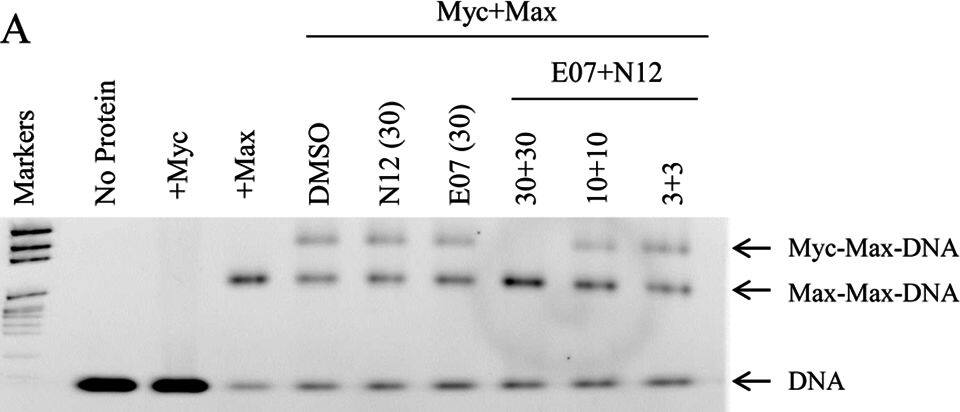Human Max Antibody
R&D Systems, part of Bio-Techne | Catalog # AF4304

Key Product Details
Species Reactivity
Validated:
Cited:
Applications
Validated:
Cited:
Label
Antibody Source
Product Specifications
Immunogen
Asp37-Ser141
Accession # P61244
Specificity
Clonality
Host
Isotype
Scientific Data Images for Human Max Antibody
Detection of Human Max by Western Blot.
Western blot shows lysates of LNCaP human prostate cancer cell line and PC-3 human prostate cancer cell line. Gels were loaded with 20 µg of cytoplasmic (Cyto) and 10 µg of nuclear extracts (Nuc). PVDF membrane was probed with 1 µg/mL Goat Anti-Human Max Antigen Affinity-purified Polyclonal Antibody (Catalog # AF4304) followed by HRP-conjugated Anti-Goat IgG Secondary Antibody (Catalog # HAF017). A specific band for Max was detected at approximately 28 kDa (as indicated). This experiment was conducted under reducing conditions and using Immunoblot Buffer Group 1.Detection of Human Max by Western Blot
The dimeric inhibitors block Myc:Max but not Max:Max binding to DNA.Gel mobility shift assay showing the effects on Myc:Max DNA complex formation by the dimeric inhibitor E07+N12 (A) and the non-dimerizable control combination E07+C12 (B). The bands that represent protein-DNA complex or naked DNA are shown on the right hand side of each panel. The concentrations indicated are in μM. Image collected and cropped by CiteAb from the following publication (https://pubmed.ncbi.nlm.nih.gov/25875098), licensed under a CC-BY license. Not internally tested by R&D Systems.Applications for Human Max Antibody
Western Blot
Sample: LNCaP human prostate cancer cell line and PC-3 human prostate cancer cell line
Formulation, Preparation, and Storage
Purification
Reconstitution
Formulation
Shipping
Stability & Storage
- 12 months from date of receipt, -20 to -70 °C as supplied.
- 1 month, 2 to 8 °C under sterile conditions after reconstitution.
- 6 months, -20 to -70 °C under sterile conditions after reconstitution.
Background: Max
Max is a member of the basic helix-loop-helix leucine zipper (bHLHZ) family of transcription factors. Max is able to form homodimers and heterodimers with other family members (Mad, Mxi1, and Myc). These homodimers and heterodimers compete for a common DNA target site (the E box (CACGTG)). MYC:MAX heterodimers are associated with transcriptional activation and cellular proliferation, whereas, the MAD:MAX heterodimers are associated with transcriptional repression and cellular differentiation. Max has six alternatively spliced transcript variants.
Long Name
Alternate Names
Gene Symbol
UniProt
Additional Max Products
Product Documents for Human Max Antibody
Product Specific Notices for Human Max Antibody
For research use only

